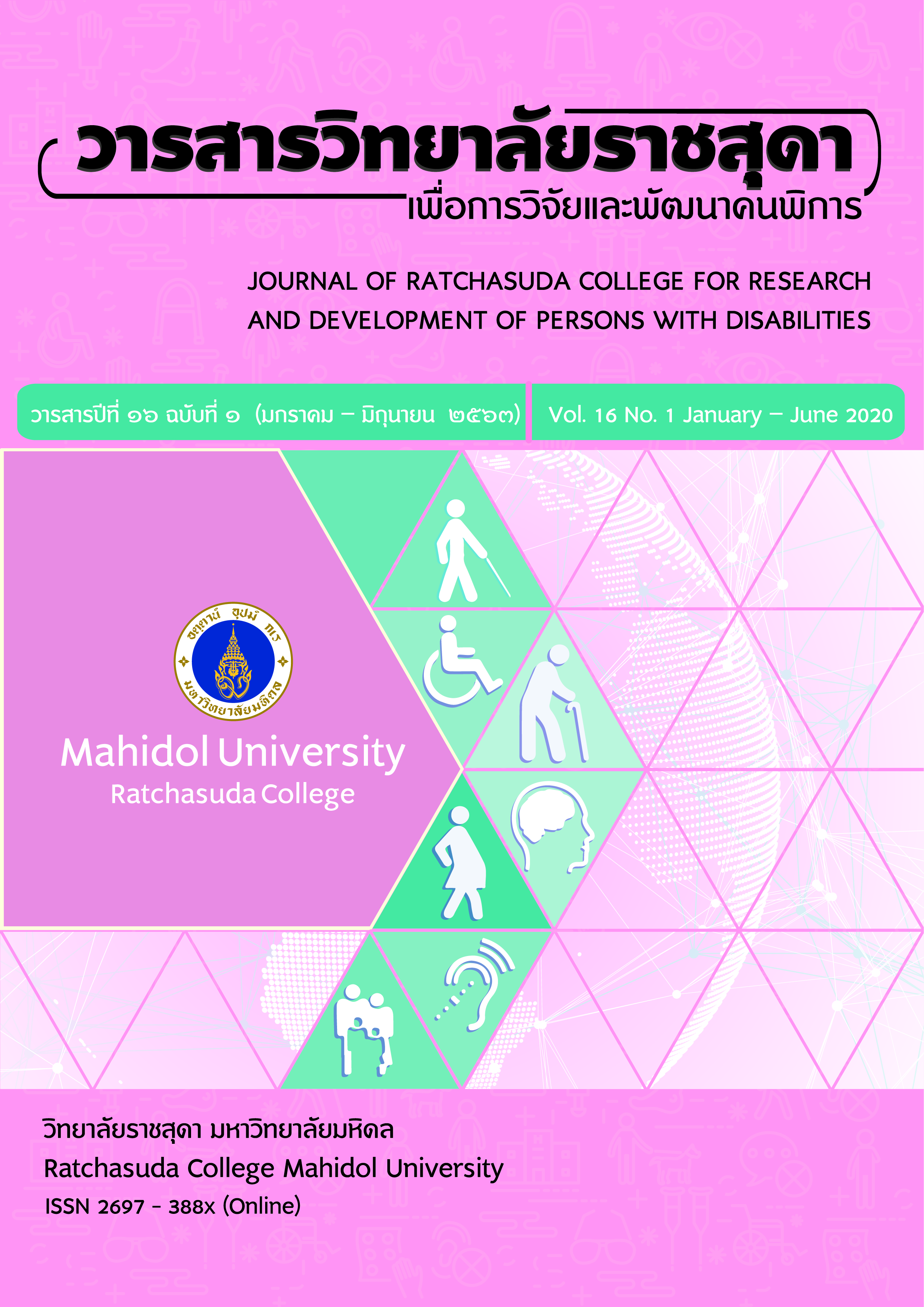The Environment Supporting Students’ Learning in School for the Deaf
Keywords:
Environment supports, Deaf students, School for the deafAbstract
The purpose of this research is to study 6 aspects of the environment supports students’ learning in school for the deaf, including: 1) physical facilities 2) curriculum 3) learning management 4) services for students 5) activities for students and 6) peer relationships, and to compare the environment management according to the perception of teachers and students. This research used a mixed-method design. Quantitative data were collected through questionnaires from 381 teachers and students in the school for the deaf in the 2018 academic year. Qualitative data were collected through in-depth interviews from 7 key informants. The data were analyzed with a statistical software using frequency, percentage, mean, standard deviation and t-test. The results of the research showed that the sample group has the level of perception, environment which is conducive to the learning of students in the Audiovisual School in the high level. And the activity environment, the sample group had the highest mean scores. As for the society and groups of friends with the lowest level of awareness. Also found that the sample group had perceived levels of environmental aspects in all 6 aspects which were not different in overall. When considering each aspect, it was found that the social environment, friends’ group there was a statistically significant level of perception of teachers and students at the .05 level.
Downloads
References
Astin, A. W. (1971). Achieving educational excellence. San Francisco, CA: Josses-Bass.
Chaiwatthanakunwanit, S. (2013). Development of an alternative educational provision model to improve quality of life of children with special needs: A case study of hearing impaired children. (Doctor of Philosophy Program in Non-Formal Education). Chulalongkorn University, Bangkok, Thailand.
Krejcie, R. V., & Morgan, D.W. (1970). Determining Sample Size for Research Activities. Educational and Psychological Measurement, 30(3), 607-610.
Lapabhawong, R. (2006). A study of the learning environment of students at Aranyaprathet school, Sa Kaeo Province. (Master of Education Educational Administration Faculty of Education). Burapha University, Chonburi, Thailand.
Mingsiritham, K., & Chanyawudhiwan, G. (2018). A Study of Using Smart Book to Enhance Communication Ability for Hearing-Impaired Students. International Journal of Emerging Technologies in Learning (iJET),13(12), 90-108.
Office of the Education Council. (2017). Education in Thailand. Bangkok: Ministry of Education.
Phra Anocha Simpha. (2010). The environment at Mahamakut Buddhist university mahavajiralongkorn rajavidyalaya campus as perceived by undergraduate student. (Partial Fulfillment of the Requirements for the Master of Education Degree in Higher Education). Srinakarinwirot University, Bangkok, Thailand.
Runseenamg, A. (2007). A study of instruction environment of the student in klongnumsaivittaykarn school under the office of sekeao education service area 2. (Master of thesis Faculty of Management Studies Faculty of Education). Burapa University, Chonburi, Thailand.
Saleekul, S. (2019). Manage the environment within the school according to the opinion of teacher civil service Ubon Ratchathani educational service area office area 5. Retrieved from http://clg.sskru.ac.th/clgpage/wp-content/uploads/2014/02/per-1.pdf
Siriattakul, P., Jamnongchan, S., Boonchuchuay, W., & Pimngern, S. (2015). Development of the Learning Management Model to Enhance Life Skills of Deaf Early Adolescents. Journal of Interdisciplinary Research: Graduate Studies, 4(3), 1-14.
Sookpatdhee, T. (2017). The Arts Use to Build Skills for Hearing Impaired. The Golden Teak : Humanity and Social Science Journal (GTHJ.), 23(2), 1-13.
Thepsarn, S. (2004). The development of an environment that is conducive to student learning at Ban Du Dua school, Mueang District, Ubon Ratchathani province. (Master of Education in Educational Administration). Mahasarakrm university, Mahasarakrm, Thailand.
Toomdee, C. (2005). Student's satisfaction toward school environment at BanBung "Auttasahakhamnukhro" school of BanBung district Chonburi provinc. (Master of Education Educational Administration Faculty of Education). Burapha University, Chonburi, Thailand.
Wangsrikun, A. (2014). Thai Studies in the 21st Century: Productivity and Development Guidelines. Humanities and Social Sciences Journal of Graduate School, Pibulsongkram Rajabhat University, 8(1), 1-17.
Wanwichai, R. (2011). A Study of Thai Dance Teaching and Learning Environment for The Deaf Students in The Special Education School in Central Area. Fine Arts Journal, 13(1), 77-88.
Downloads
Published
How to Cite
Issue
Section
License
บทความที่ได้รับการตีพิมพ์เป็นลิขสิทธิ์ของวารสารสถาบันราชสุดาเพื่อการวิจัยและพัฒนาคนพิการ






